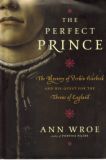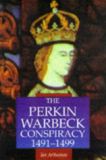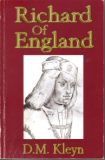Three Books on Perkin Warbeck
Ian Arthurson, The Perkin Warbeck Conspiracy 1491-1499. Alan Sutton Publishing, Stroud, United Kingdom, 1994. ISBN 0-86299-742-9
Diana M Kleyn, Richard of England. Jacobyte Books, Mitcham, Australia, 2000. ISBN 1-74053-100-0
Ann Wroe, The Perfect Prince. Random House, New York, USA, 2003. ISBN 1-4000-6033-8 (this book was originally published in Britain as Perkin: A Story of Deception)
Three books representing three different views of the young man known as Perkin Warbeck: as the titles indicate, Arthurson sees him as an impostor, Kleyn believes he really was Richard of York, whereas Wroe is undecided.
 Ann Wroe’s The Perfect Prince is the most extensive of the three. Anyone interested in the subject will be rewarded with a wealth of information. Her command of the English language makes the book highly readable. As Wroe herself states in her introduction “this book is about a mystery”, it is therefore rather disappointing for the reader that the book does nothing to solve the mystery. Her suggestion that Perkin/Richard in the end did not know himself who he really was, does appear as an too easy way out.
Ann Wroe’s The Perfect Prince is the most extensive of the three. Anyone interested in the subject will be rewarded with a wealth of information. Her command of the English language makes the book highly readable. As Wroe herself states in her introduction “this book is about a mystery”, it is therefore rather disappointing for the reader that the book does nothing to solve the mystery. Her suggestion that Perkin/Richard in the end did not know himself who he really was, does appear as an too easy way out.
She has to be applauded on her diligent research into anything which might have something to do with her character or his period. However, a bit more restraint with what eventually was included in the book would have been beneficial. Long passages digressing from the main story with only a very tenuous connection to it are somewhat boring.
For a book that wants to be – and deserves to be – considered to be serious historical research there are several flaws which make it appear more like historical fiction. One is her habit of describing as factual what people thought or felt, going so far as ending her book with what happened to her protagonist’s soul in purgatory. While there is no problem speculating on why people behaved the way they did, that is all it is – speculation. Another is that there is no critical evaluation of her sources, whatever anyone ever said is taken as fact. There is no discussion of her sources political allegiance and environment or even of the time in which they wrote, both of which would have influenced their perspective.
Apart from these text-inherent concerns , there are also two with the outlay of the book. There are no conventional footnotes marked in the text, the notes in the end are preceded by a short quote from the text. Another is that it does not contain a separate bibliography of her sources. Both of which make it look more like fiction.
On the whole the book is less suited to a reader with little or no knowledge of the period. It will, however, offer an extremely valuable mine of information to the reader with a fairly solid previous knowledge as well as an opinion as to the identity of the protagonist.
 Ian Arthurson’s highly readable The Perkin Warbeck Conspiracy on the other hand wants to send a clear message to the reader: Perkin Warbeck was not Richard of York, but an impostor, who became against his will the figurehead in a plan by John Taylor and others to promote an English rising on behalf of Edward, Earl of Warwick. Arthurson offers an extensive array of information to demonstrate his theory. The main problem with the book is that he starts off with a preconceived idea, which remains unquestioned. According to the author “there is nothing in Warbeck’s confession which should make us doubt its truthfulness”. Anyone coming to a different opinion “is shutting the door after the horse has bolted with a vengeance”. A more critical consideration of the opposing view would have resulted in a more convincing book.
Ian Arthurson’s highly readable The Perkin Warbeck Conspiracy on the other hand wants to send a clear message to the reader: Perkin Warbeck was not Richard of York, but an impostor, who became against his will the figurehead in a plan by John Taylor and others to promote an English rising on behalf of Edward, Earl of Warwick. Arthurson offers an extensive array of information to demonstrate his theory. The main problem with the book is that he starts off with a preconceived idea, which remains unquestioned. According to the author “there is nothing in Warbeck’s confession which should make us doubt its truthfulness”. Anyone coming to a different opinion “is shutting the door after the horse has bolted with a vengeance”. A more critical consideration of the opposing view would have resulted in a more convincing book.
 At the other end of the spectrum is Diana Kleyn’s Richard of England. Of the three books it is to be considered the most interesting and most accessible for a novice to the Perkin Warbeck affair. Kleyn is critical of Tudor propaganda and thoroughly analyses her information with a fair dose of common sense, thus making a compelling case that the young man really was Richard of York. The book contains a comprehensive bibliography. It is a fascinating read and the only criticism must be that there is not more of it.
At the other end of the spectrum is Diana Kleyn’s Richard of England. Of the three books it is to be considered the most interesting and most accessible for a novice to the Perkin Warbeck affair. Kleyn is critical of Tudor propaganda and thoroughly analyses her information with a fair dose of common sense, thus making a compelling case that the young man really was Richard of York. The book contains a comprehensive bibliography. It is a fascinating read and the only criticism must be that there is not more of it.
